By the time they talk to a salesperson, 85% of buyers already have a preferred vendor. Eight in ten will buy from the first one they talk to. Never has marketing mattered so much—B2B sales is now a marketer’s game and your marketing team can be the difference between you entering all of those deal cycles as “preferred” or not.
To become preferred, you need the right approach, which changes when going from zero to $10 million, $10-100 million, and so on. Each stage requires new strategies, skills, leadership, and of course, teams.
That leaves you with choices to make—especially as you start out. For example, should you be hiring for experience or innovativeness? That is, should you hire people who are senior and have risen through several startups and can pattern match and know best practices? Or do you hire people native to this era, unafraid of vertical video, and who can prompt AI to achieve what just a decade ago would have required an expensive martech stack?
This guide will help you tackle these questions and more. It draws upon research and insights from my own experience and that of our portfolio. It lays out the best practices for hiring, organizing, and managing marketing leaders at a startup of any size, as you grow.
Key marketing positions at each phase
At its simplest, the goal of marketing is to educate the marketplace to make it ready for your goods. Marketers can rarely create demand out of nothing, though there are exceptions. Your marketing team should focus on creating an environment where it is easier for demand to emerge—and where buyers develop a bias toward your product.
At its simplest, these are the “jobs to be done” in a typical marketing org:
- Lead the team
- Understand the buyer
- Build the brand
- Communicate the story
- Capture demand
- Produce content
- Retain and grow customers
A mature marketing organization (Series C or D) breaks these jobs out into a team of many discrete functions, led by senior executives who set the strategic vision for the org, whereas earlier-stage organizations typically ask leaders to simultaneously oversee multiple ‘jobs’ at once. Pictured below is a rough outline of the roles you will need at each stage.
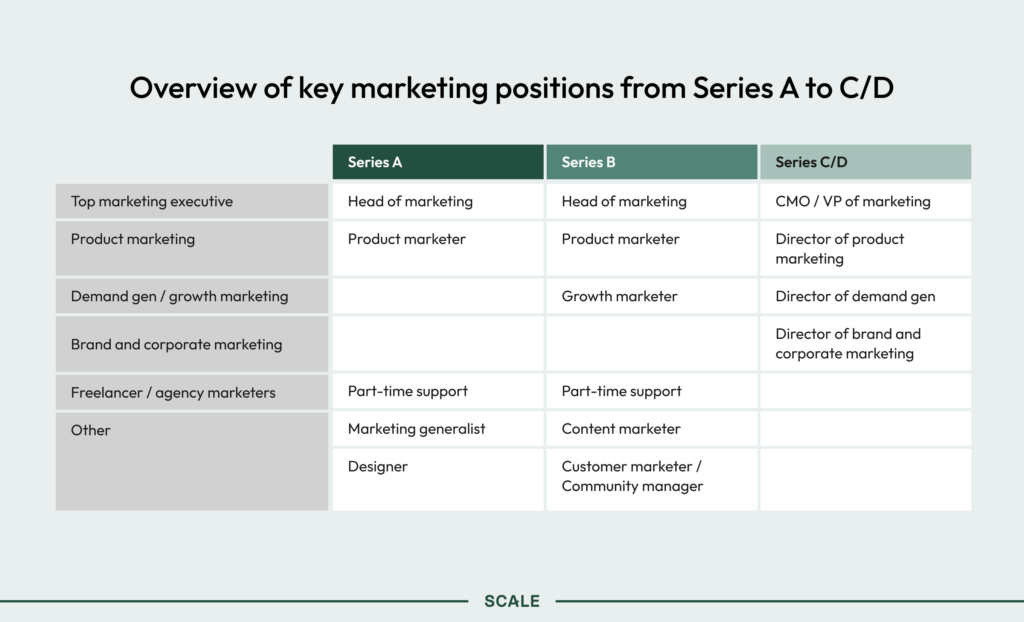
Let’s explore how you get there.
Getting started: seed stage
At the seed stage, founders should manage marketing. Very few founders have direct experience with marketing but they are long on the one skill central to all types of marketing: customer knowledge. If marketing is a question of, “What are buyers thinking?”, founders who build and sell are a unique source of truth.
This never stops being true. No matter how complex a marketing technology or motion is, customer insight makes it better. One does not simply “conjure” clicks out of raw advertising talent. You must know something about the buyer.
At the seed stage, you are likely to grow through founder-led sales and direct relationships, so the marketing you need is of the “starter kit” variety. Your goal right now is to navigate to product-market fit and gain traction. Do the minimum-viable marketing to achieve that.
Complete the following list yourself with your team (and possibly, a few contractors), to learn before making your first marketing hire.
Your marketing self-starter to-do list:
- Define the company’s mission
- Create the basic brand assets (logo, color palette, font)
- Purchase the domain
- Design and build the website
- Develop your founder brand
- Launch your initial product
- Publish your first few customer stories
- Create and maintain a basic contact database
Note that your initial “brand” is not your final identity. You’ll likely work with a designer or agency to get to something you’re comfortable with, that is “good enough.” There is a school of thought that you should do the full identity first, and have it done by professionals because it clarifies your every message. That can work if you are experienced in brand and have a core insight for them to build upon. However, we recommend only doing it when you know the problem you solve well enough that you aren’t likely to pivot to new problem areas or buyer types in the not-too-distant future.
In addition to the above, you might run some low-cost experiments, like launching your own early paid performance ads on Google, LinkedIn, Facebook, and similar or doing some early SEO or generative search (GEO) work by writing strongly opinionated 1,800-word articles.
Make your first hire
With the basics being in place, you may be ready to bring your first A player in, so to speak. You’ll have to decide if you’ll hire a senior leader or someone more junior. And also a specialist or a generalist, which have a different range of skill areas.
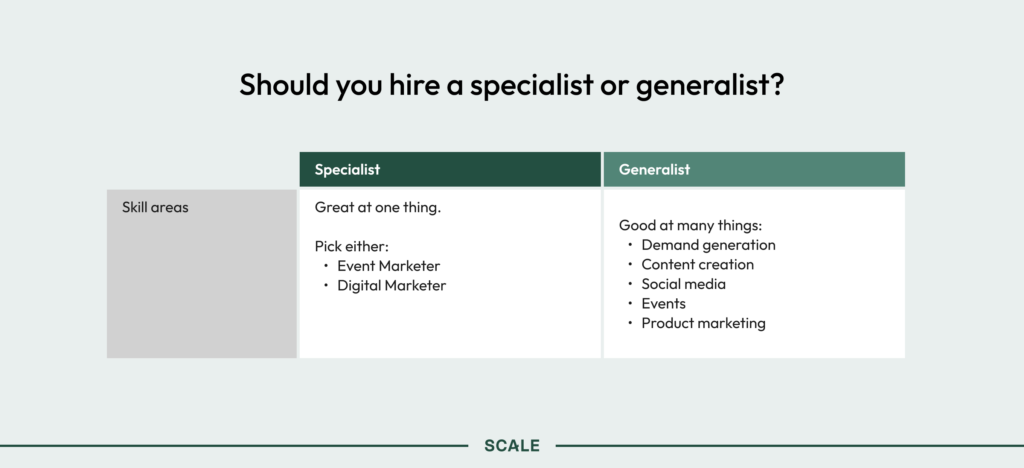
At this stage, you’ve probably hired at least one salesperson. Hopefully, you’ve hired an individual with experience selling without robust marketing support because they won’t have much for a while. The marketer will take time to ramp and marketing takes time to show results.
That first marketing hire can then bring in outside contractors and micro-agencies who can supplement. This is one argument for hiring a senior person first—they’ll already know “their people” to hire on contract. If it’s all working as you’d hoped, consider hiring a second marketer to complement the first where they are weak.
Series A is where you start to grow
Everything changes with marketing when you reach your Series A. At this point, you have initial product-market fit and need to ramp up demand quickly and consistently. That means starting to grow your team. The CEO will have to step back as their job gets busier and busier, and you need to generate pipeline for a growing sales team.
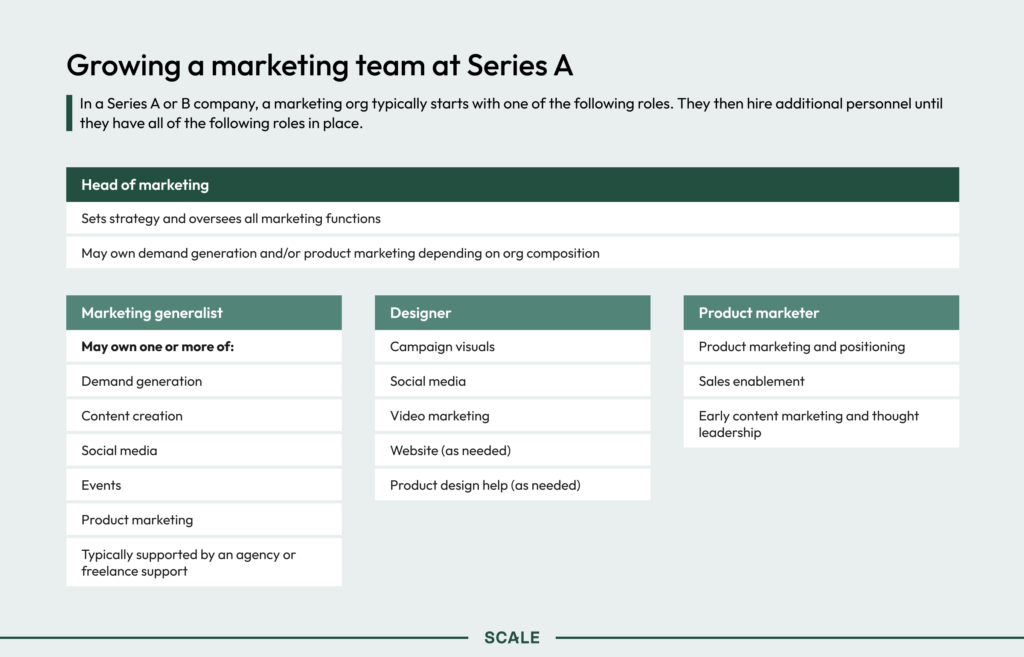
You’ll typically hire people to fill each of the above roles until you have all of them covered. If you already had an exceptionally strong marketing generalist or specialist on payroll during your seed stage, you might consider moving them into the head of marketing position. Otherwise, you’ll likely want to hire a head of marketing to oversee specialized functions like design and product marketing. Additionally, they can work with a more junior generalist to tackle everything else (demand generation, events, etc.).
By Series B, you’ll need more structure
At about this point, you have reached a Series B and the organization grows more complex. To support the increasing number of initiatives you’ll want marketing to coordinate, you need a marketing leader. If you haven’t already hired that person, do so now.
Hiring that leader will allow you to break the generalist’s former duties into more discrete marketing functions. Recall our “jobs to be done” list. Your head of marketing will lead the team. Your product marketers understand the buyer. Your growth team handles all those digital marketing functions around reaching new audiences, targeting buyers, sending messages, and capturing demand. Your customer marketer/community manager focuses on retaining and growing relationships with existing customers. The content team could be embedded within product or demand, but at this stage is often best as a standalone center of excellence for creating content. That said, content is the easiest function to outsource if you have a strong product marketing function and can write well-informed briefs.
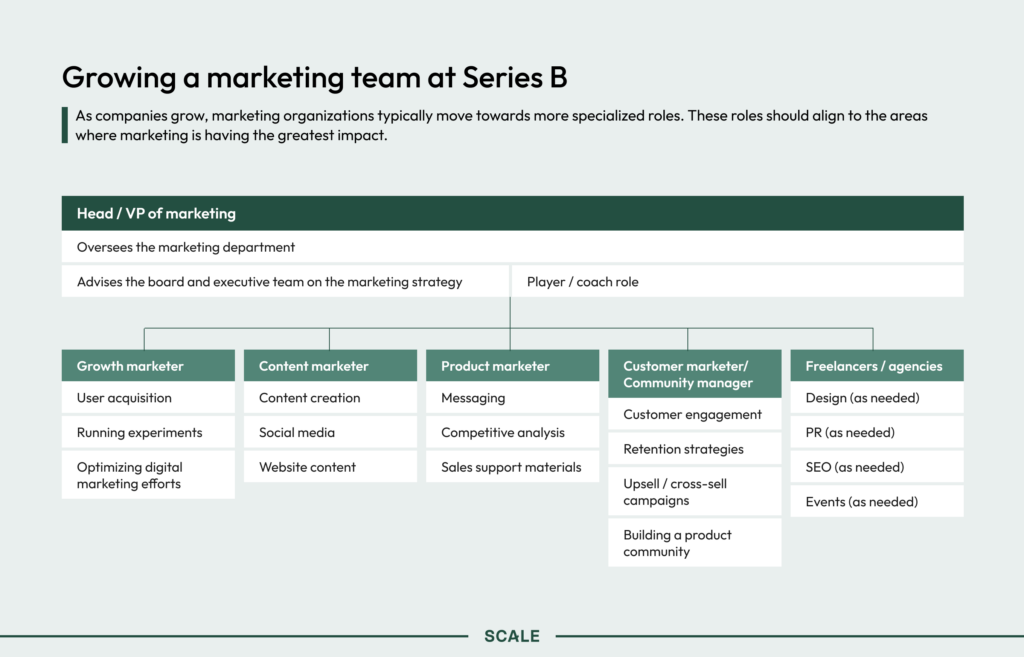
By Series C or D, you need departments
Finally, as headcount accumulates during your Series C or D period, your increasingly specialized teams should start to split into three separate departments with their own people managers: brand and corporate marketing, product marketing, and demand marketing.
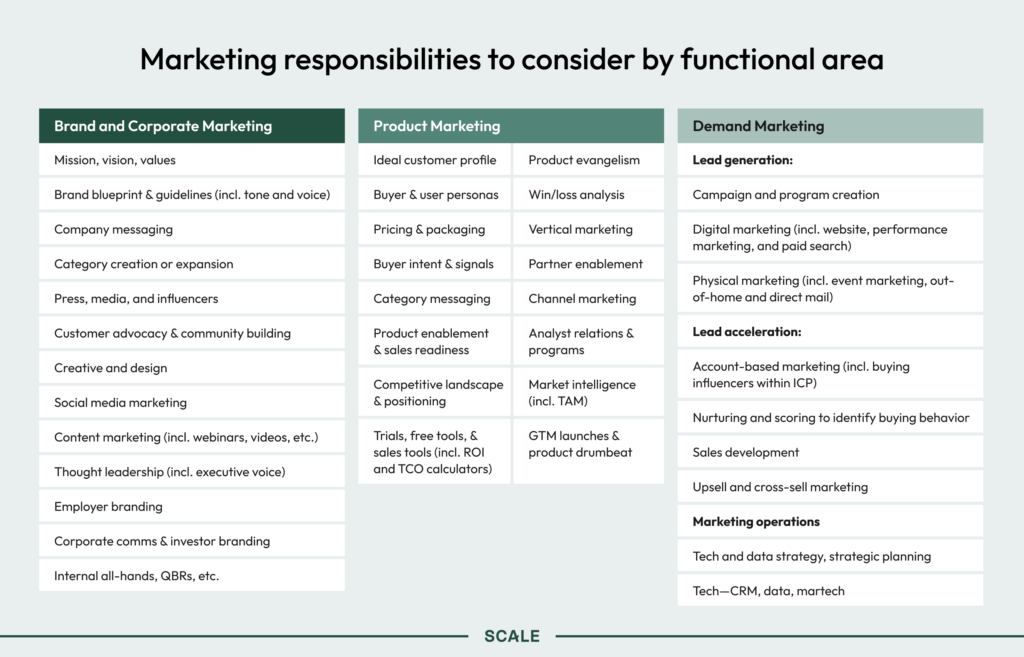
At this stage, you may start hiring administrative and enabler roles, such as creative operations or marketing operations. This is also likely when you’ll shift from a “head of” or director-level role to a CMO/VP of marketing, with directors reporting into them.
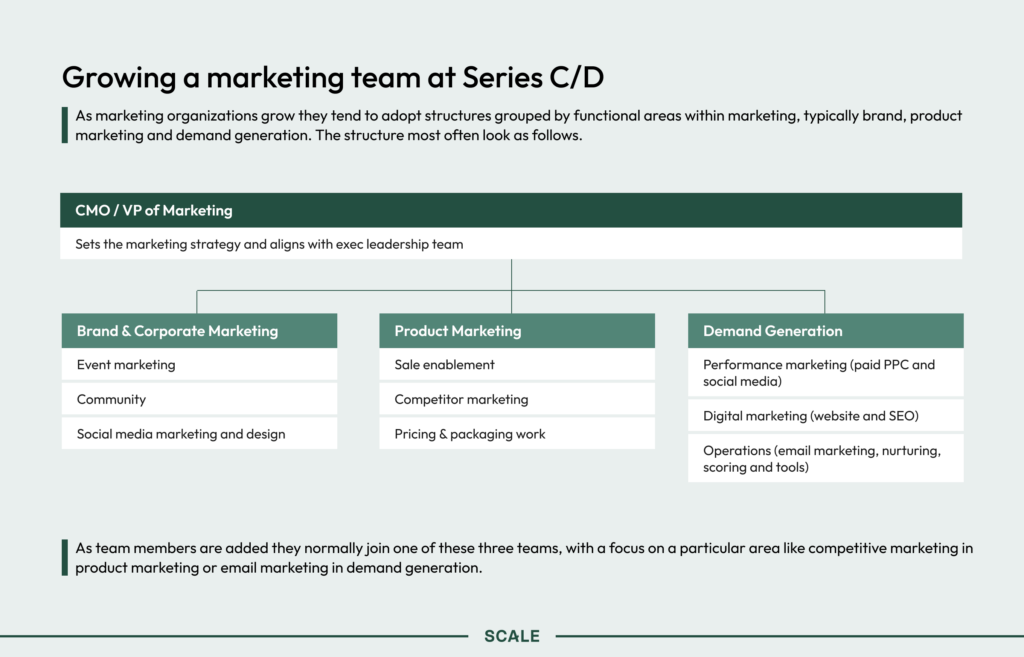
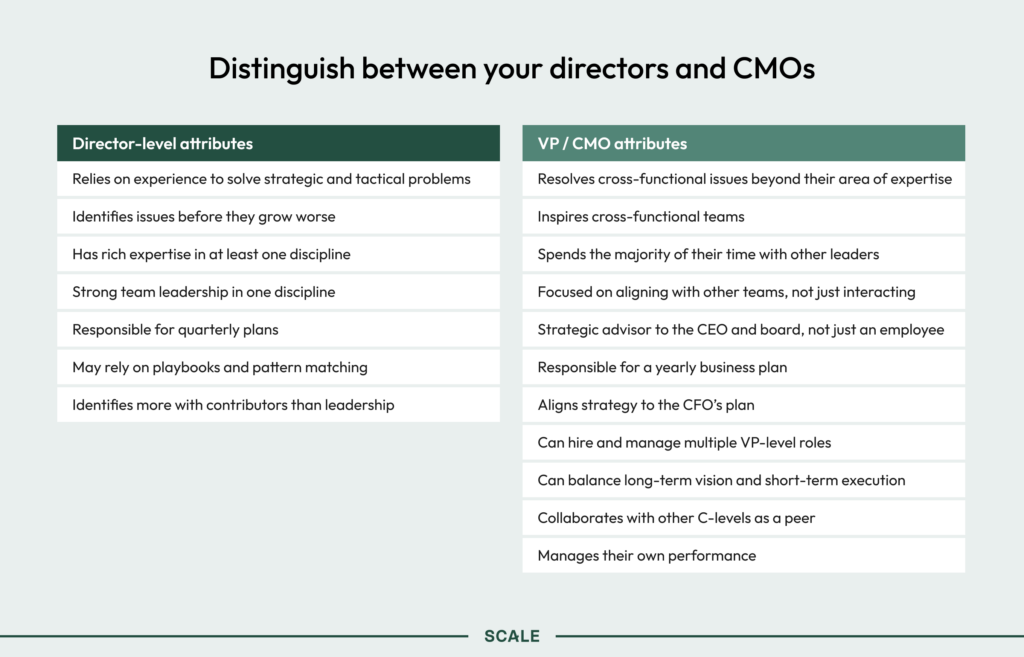
On managing your marketers
It’s good to allow your marketing leader to grow the team as they see fit, but do not let the organization outgrow its contribution to revenue. Marketers of the past relied on largely superficial metrics like first-touch and last-touch attribution for leads, but those measurements are no longer the best practice. That approach led to constant rivalry with sales. Instead, your marketers should be able to speak to how they indirectly generate revenue. This doesn’t mean you need to know the ROI of every article—that’s not how marketing or your buyers work—but, as a whole, the function should demonstrably contribute.
You’ll know when it’s all working, and your marketing effective. A meaningful number of buyers will come in already knowing your product. You’ll be included in lists, get mentioned on social media, and people will thank you for your content. And you can continulally challenge your marketing team to ask:
- Do we understand the buyer?
- Do we have a brand?
- Are we communicating the story?
- Are we generating demand?
- Are we producing winning content?
- Are we retaining and growing our existing customers?
If so, you’ve successfully scaled your marketing org from seed to Series D and are prepared to continue beyond.
This guide is written from materials our Executive-in-Residence Maria Pergolino generated as part of a talk series.